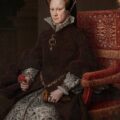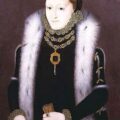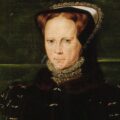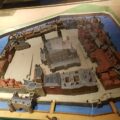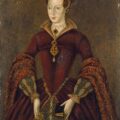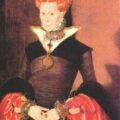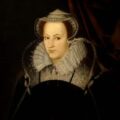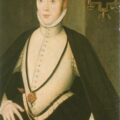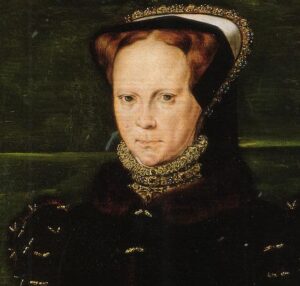
“her gowne of purple velvet French fashion, with sleues of the same, hir kirtle purple satten all thicke sett with gouldsmithes work and great pearle, with her foresleues of the same set with rich stones, with a rich bowdricke of goulde, pearle, and stones about her necke, and a riche billement of stones and great pearle on her hoode, her pallfray that she rode on richly trapped with gould embrodred to the horse feete.”
Mary was then welcomed by the Lord Mayor of London who presented her “with the scepter perteyninge to the office”. After thanking the Lord Majory and the aldermen for their “gentlenes”, Mary handed the sceptre back to him and entered the city followed by Sir Anthony Browne, “the Lady Elizabethes Grace, hir sister”, the Duchess of Norfolk, the Marquess of Exeter and various ladies. In front of the Queen, processed the Lord Mayor with the sceptre and the Earl of Arundel bearing the sword.
The royal party passed St Buttolphes Church (St Botolph’s), where she was greeted by the children of Christ’s Hospital, through Aldgate, which was decorated with arras and streamers, past Leadenhall, down Gracechurch Street, up Fenchurch Street, down Mark Lane and to the Tower of London. There Mary was met by Sir John Gage, the Constable of the Tower, and Thomas Bruges, who welcomed her to the Tower. After entering the Tower, Mary encountered the Duke of Norfolk, Bishop Gardiner and Edward Courtenay who knelt and asked for her to pardon them, she saluted them “biddinge them ryse up.”
Wriothesley’s Chronicle goes on to describe the city of London as it celebrated the accession of its new Catholic Queen, the daughter of their beloved Bluff King Hal:-
“All the streates in London, from Algate up to Leadenhall, and so the the Tower, were richly hanged with clothes of arras and silke, the streates gravelled all the way, and the citizens standinge at rayles with theyr streamers and banners of eury Company or occupation standinge at theyr rayles, eury Company in their best liueryes with theyr hoodes. Allso there were iiii great stages between Algate and the Tower where clarkes and musicians stoode playinge and singinge goodly ballets which reioysed the Quene’s highnes greatly. Allso there was such a terrible and great shott of guns shot within the Tower and all about the Tower wharf that the lyke hath not bene hard, for they neuer ceased shootinge from the tyme her highnes entred in at Algate til she came to Marke Lane ende, which was like great thunder, so that yt had bene lyke to an earthquake. And all the streets by the way as her highnes rode standing so full of people shoutinge and cryinge Jesus saue her Grace, with weepinge teares for ioy, that the lyke was neuer seen before.”
It is obvious that the people were happy to see their new queen and nobody seems to have given a thought to the fate of Lady Jane Grey, the young woman who was Queen from the 6th July to the 19th July after being named Edward VI’s heir in his “Device for the Succession”. Who knows what Elizabeth thought of the events but she knew it was sensible to show her support for her half-sister, England’s new Queen.
Notes and Sources
- Wriothesley’s “A Chronicle of England during the reigns of the Tudors, from AD 1485 to 1559 – Volume II”, p93-95. You can read this online at http://www.archive.org/details/chronicleofengla02wriouoft
